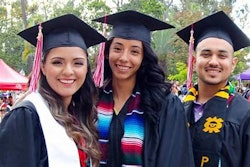Surging in the Southeast
North Carolina HBCUs expected to play significant role in facilitating college access for the increasing Latino population in the region
By Ronald Roach
 Given the surging growth in the U.S. Latino population in recent years, nowhere have those increases been occurring faster than in the southeast. North Carolina, Arkansas and Georgia, for example, have seen population increases between 300 and 400 percent since the early 1990s. Naturally, Latino community leaders and state officials have been eager to grow Latino enrollment in higher education — a task complicated by the reality that Latinos are struggling with a high public school dropout rate, estimated at 47 percent in North Carolina, and attend college at lower percentages than Whites and Blacks.
Given the surging growth in the U.S. Latino population in recent years, nowhere have those increases been occurring faster than in the southeast. North Carolina, Arkansas and Georgia, for example, have seen population increases between 300 and 400 percent since the early 1990s. Naturally, Latino community leaders and state officials have been eager to grow Latino enrollment in higher education — a task complicated by the reality that Latinos are struggling with a high public school dropout rate, estimated at 47 percent in North Carolina, and attend college at lower percentages than Whites and Blacks.
In North Carolina, the task to increase and support Latino college enrollment is one shared by a host of institutions and agencies, including historically Black colleges and universities. Among the 16 public colleges in the state, historically Black Fayetteville State University (FSU) had the highest share of Latino students, 4 percent, during the 2003-2004 academic year, according to state officials. This year’s numbers have Latino enrollment at 4.1 percent.
There’s an expectation that HBCUs, such as FSU, will play a role as great as that of the majority White colleges and universities in facilitating Latino college enrollment in North Carolina colleges and universities, according to state officials.
“We are making some intense efforts to strengthen our support of Hispanic students,” says Dr. Jon Young, the associate vice chancellor for enrollment management at Fayetteville State.
Dr. Robert Kanoy, associate vice president for academic affairs for the University of North Carolina system, explains that the public universities are increasing the diversity of their campuses with Latino student outreach efforts. He says it’s imperative that all the schools become proficient in developing multi-cultural environments because demographic projections show that Latinos will surpass Blacks in the state’s college-age population around 2018 and that student growth will continue to surge among Latinos while the growth numbers of Black and White students will level off after 2014.
“The HBCUs will have a smaller pool of students to compete for if they don’t become more diverse,” Kanoy says.
In North Carolina, Latinos made up 1.7 percent of the 183,000 students at the state’s public universities in 2003-2004. Officials say they are the fastest-growing segment of the student body. Fayetteville State, which has around 5,400 students, recorded a 42 percent Latino student growth jump between 1998 and 2004.
Young says that FSU has attracted Latino students largely because Fayetteville is located in a region heavily populated with Mexican immigrants. He attributes the 4 percent rate of Hispanic enrollment to the accessibility of FSU to a large Latino population and to outreach efforts by the university. The school is more diverse than most HBCUs with a student population that is 25 percent non-Black, Young notes. White students have become roughly 17 percent of FSU’s population in recent years. The school draws upon a pool of commuting students as well as people affiliated with Fort Bragg, a nearby U.S. Army base.
This past summer, the FSU enrollment management office hired an admissions counselor who specializes in Latino student and community outreach. The school is also translating its admissions literature into Spanish-language documents, according to Young.
“We expect that prospective students already read and write English so the Spanish-language documents will help their families understand our institution,” Young says.
Marco Zarate, the president of the North Carolina Society of Hispanic Professionals (NCSHP), says the public four-year colleges and the community colleges in North Carolina have shown responsiveness to the plight of Latino residents in the state. He notes that the HBCU community in North Carolina has been welcoming to Latino students. His organization, which advocates quality education for North Carolina Latinos, has recently established the North Carolina Hispanic College Fund. As part of the fund, the group is working with historically Black North Carolina Central University to develop endowed scholarships for Latino students going into teacher education, according to Zarate.
“We know the efforts of the HBCUs to reach out to Latinos. We have good friends at those schools,” he says, noting that private HBCUs Shaw University and St. Augustine College have also made efforts to work with his organization.
“The HBCUs have done a lot of targeted outreach for all groups of students,” Kanoy says, adding that the public colleges have also beefed up their participation pre-college programs, such as GEAR-UP, in coordination with local school districts.
In October, the NCHSP will host the second Hispanic Achievement Conference, which is to be held on the campus of North Carolina State University in Raleigh, N.C. The conference objective is “to serve as a forum to address issues impacting our Hispanic students, and discuss best practices that are practical and applicable in the school environment, to increase the academic achievement of the Hispanic students in North Carolina,” according to conference organizers.
Zarate says the conference, which drew 400 attendees in 2003, draws largely people from the K-12 community but the discussions naturally involve higher education issues. One particular issue needing more attention, according to Zarate, is that of higher education access for undocumented aliens, or immigrants who may be residing illegally in the United States. It’s estimated that 1,450 undocumented immigrants graduated from North Carolina high schools this spring, according to El Pueblo, a Raleigh-based Latino advocacy group. Currently, public universities in North Carolina don’t offer them financial aid, according to officials.
“That’s a big obstacle,” Zarate says, noting that more access for undocumented students could help grow the Latino enrollment in the public colleges well beyond the 3,100 currently attending the four-year schools.
GROWING THE CONNECTIONS
Dr. Maria DeGuzman, an English professor at the University of North Carolina-Chapel Hill (UNC), has spearheaded the launch of a Latina/o studies minor, reportedly the first such academic program at a southeastern university. DeGuzman, who founded a Latina/o speaker series at the flagship UNC campus in 1999, says part of the rationale for starting the minor was to make it part of the school’s effort to attract Latino students.
After gaining university approval of the minor, which draws upon courses offered in a variety of academic disciplines and begins this fall, DeGuzman has spent time speaking to Latino community groups to develop awareness about the academic program. She has also worked with the UNC development office to develop fund-raising efforts to support the minor with new course development as well as for Latino student recruitment to UNC-Chapel Hill. The school had a 2.2 percent Latino enrollment during the 2003-2004 academic year.
“Part of the reason behind the minor is to strengthen the university’s ability to recruit Latinas and Latinos as students,” DeGuzman says.
To earn the minor, students are required to take five courses in a range of areas so that their study plans are considered Latina/o studies instead of a concentration in one discipline, such as literature or history. The requirements are one core course in the humanities, a core course in the social sciences and three electives distributed between humanities and social sciences.
DeGuzman explains that although UNC has a program in Latin American studies, there was no formal Latina/o studies program until this fall. “Unlike Latin American studies, where the focus is on the cultures and experiences of various parts of Latin America, Latina/o studies takes as its primary concern the presence of Latin American, Spanish and the many combinations of Hispanic, Native, African and Asian cultures within the borders of the United States,” she says.
The committee overseeing the minor include members who represent various disciplines in the humanities and the social sciences, including anthropology, African American studies, dramatic arts, English, geography, health and human behavior, history, journalism and mass communication, music, public policy and Romance languages.
DeGuzman stresses that it’s part of the university’s public mission to offer academic programs that speak to and reflect social and demographic changes in the state’s population. “You don’t want to just have an academic program that has no basis, or no impact. Such programs do exist, but it seems a bit socially irresponsible to have a program, in effect, that doesn’t affect the way in which higher education interacts with populations living in this country,” she says.
“It seems high time for the university, if it’s going to have American studies, if it’s going to have American Indian studies and all of these other studies, doesn’t it make sense to have Latina/Latino studies?” DeGuzman adds.
© Copyright 2005 by DiverseEducation.com


















